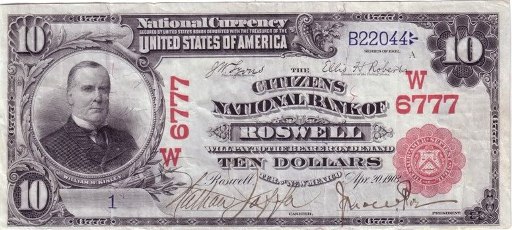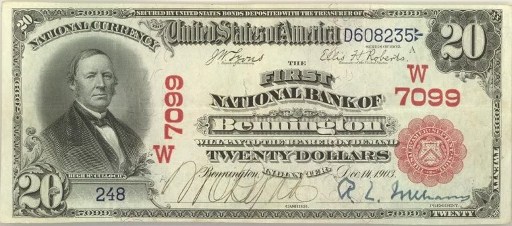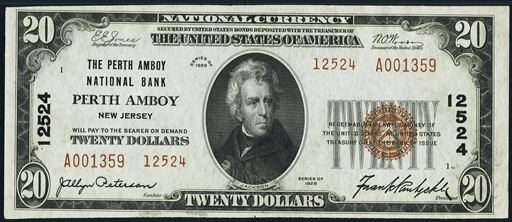The First National Bank Of Prague
The First National Bank Of Prague in Oklahoma printed $464,650 dollars worth of national currency. That is a pretty standard output. However, some types of currency from this bank could still be rare. This national bank opened in 1904 and stopped printing money in 1935, which equals a 32 year printing period. That is a fairly normal lifespan for a national bank. During its life, The First National Bank Of Prague issued 8 different types and denominations of national currency. We have examples of the types listed below. Your bank note should look similar. Just the bank name will be different. For the record, The First National Bank Of Prague was located in Lincoln County. It was assigned charter number 7177.
We buy all national currency. Please call or email us for a quote. Sales@AntiqueMoney.com
The First National Bank Of Prague in Oklahoma printed 963 sheets of $10 1902 territorial red seal national bank notes. A print run under 1,000 will get the attention of most people. Combine that with a territorial and you have a real winner. This denomination and type was the most prolifically issued territorial note. Some can be quite rare. There is a hierarchy in terms of rarity. Red seals from Hawaii are the absolute rarest. In fact, none from Hawaii are currently known to exist. Ten dollar red seals from Porto Rico are also extremely rare, as are red seals from Alaska. The average collector is most likely to encounter red seals from Arizona, New Mexico, and Oklahoma. There were far more territorial banks in Oklahoma during the red seal period than any other state, so notes from Oklahoma are the most common. However, most all red seals should be worth more than $10,000, and sometimes considerably more. William McKinley is pictured on the left hand side of each bill. The number under McKinley is the bank serial number. If that number is #1, then you can expect an additional premium on the value.
1902 $10 Red Seal Territorial National Bank Note
The First National Bank Of Prague printed 963 sheets of $20 1902 territorial red seal national bank notes. That of course equals the number of sheets printed for the ten dollar denomination. A total of 259 national banks in the country issued $20 territorial red seals. There are currently only about 30 of them known to exist, and that total includes all national banks. That survival rate is really poor. That means that these notes are rare and valuable. They were usually printed in small quantities and very few new ones are found these days. High grade examples are scarce as are notes printed by banks not located in Oklahoma.
1902 $20 Red Seal Territorial National Bank Note
The First National Bank Of Prague also printed 6,553 sheets of $10 1902 blue seal national bank notes. That is a fairly standard sheet output for a national bank issuing blue seals. You likely aren’t dealing with a super common or a super rare bank note. 1902 $10 blue seal bank notes all have a portrait of William McKinley on them. Values can range from as little as $40 up to over $10,000. There really is no trick to know what is rare and what is common by just doing an internet search. You really need to work with an expert (like us) in order to determine the value of your specific bank note. There are at least ten different factors than can make some 1902 $10 blue seals worth more than others. We know exactly what to look for and we would be happy to provide a free appraisal and our best offer.
1902 $10 Blue Seal National Bank Note
The First National Bank Of Prague also printed 6,553 sheets of $20 1902 blue seal national bank notes. The same rarity rules for 1902 $10 blue seals also apply to $20 blue seals. Just remember that $20 bills are by nature three times rarer (unfortunately they don’t command a premium over other denominations). Hugh McCulloch is pictured on the front of each bill. Contact us if you need pricing help.
1902 $20 Blue Seal National Bank Note
The First National Bank Of Prague also printed 790 sheets of Type1 1929 $10 national bank notes. This is a small print range, but it does not guarantee rarity. Each $10 bill from 1929 has a portrait of Alexander Hamilton on it. The black number written vertically is the charter number. The charter number never affects the value; it is just an identifier. The ten dollar type1 national bank note happens to be the single most common national bank note, with over 65,000 known to exist from all banks. Of course each note is valued based on its condition and rarity. Some are very rare.
Series of 1929 Type1 $10 National Bank Note
The First National Bank Of Prague also printed 204 sheets of Type1 1929 $20 national bank notes. That may sound like a very small number, and it is. However, when it comes to small size notes, that print range usually allows for a handful of survivors. Andrew Jackson is featured on the front of each 1929 $20 bill. Be sure to take note of the serial number on your specific bank note. If it is 000001 then you can expect a nice premium. There is a special market for serial number one bank notes. Of course, even if the number isn’t #1, it could still be collectible and have a high value just based on its condition and rarity alone.
Series of 1929 Type1 $20 National Bank Note
The First National Bank Of Prague also printed 1,049 individual notes from the type2 1929 $10 national bank note series. That may seem like a high number, but remember that is total notes printed for the denomination, not sheets printed. The easiest way to spot the difference between type1 1929 $10 bills and 1929 type2 $10 bills is in the serial number. Type2 notes have a serial number that ends with a number. 1929 type1 notes have a serial number that ends with the letter A. Generally speaking, these $10 bills are rarer than the earlier type1 issues. However, most collectors don’t pay more for that rarity because they look basically the same.
Series of 1929 Type2 $10 National Bank Note
The First National Bank Of Prague also printed 324 individual notes from the type2 1929 $20 national bank note series. Type2 1929 national bank notes are already rare to begin with. A printing of less than 1,000 is especially low. One of the great things about 1929 type2 $20 national bank notes is that they really aren’t that old and some can be extremely rare. Until the big head $20 series started there really wasn’t much difference between something printed in 1929 and the same bill printed in 1993. We have bought some examples in the past few months that people just found in their change.
Series of 1929 Type2 $20 National Bank Note



